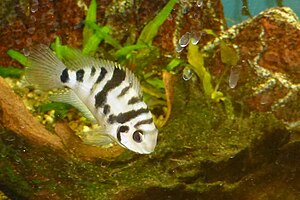Amatitlania siquia
| Amatitlania siquia | ||||||||||||
|---|---|---|---|---|---|---|---|---|---|---|---|---|

Form from Lake Xiloá |
||||||||||||
| Systematics | ||||||||||||
|
||||||||||||
| Scientific name | ||||||||||||
| Amatitlania siquia | ||||||||||||
| ( Günther , 1867) |
Amatitlania siquia is a freshwater fish from the cichlid family (Cichlidae). It is distributed from Costa Rica (from the tributaries to the Gulf of Nicoya on the Pacific side and the Rio Parismina on the Atlantic side) via Nicaragua (various rivers, Lake Managua , Lake Nicaragua , Lake Xiloá ) to the Caribbean side of Honduras . The species was named after the type locality of the Rio Siquia in the Atlantic Nicaragua. “Siquia” means avocado in the Miskito dialect Ulwa.
features
Amatitlania siquia is very similar to the zebra cichlid ( Amatitlania nigrofasciata ) known from the aquarium hobby , but with a higher back. The black transverse bands on the sides of the body are more strongly fused together at their lower ends than in other Amatitlania species. The fourth bandage is simple and not V-shaped, the head bandage is particularly strong towards the back. The under-eye stripe is clearly visible in juvenile fish, in larger fish usually a stripe from the eye to the mouth. The breast is olive-colored, the base of the pectoral fin is whitish. The posterior section of the dorsal and anal fin can be spotted. The oval tail spot, lying above rather than below the second lateral line , is two-thirds on the caudal peduncle and one-third on the fin and never reaches all the way down. Compared to A. nigrofasciata , Amatitlania siquia has fewer scales around the caudal peduncle. The peritoneum is rostrally pigmented ( completely dark pigmented in A. nigrofasciata ). The os quadratum ("square leg") is wider than it is long. The gill rakes on the first gill arch are often split in two. Between the first lateral line and the base of the hard-nosed dorsal fin section there are 1.5 rows of scales. The scales between the rays of the dorsal fin are in one row.
- Fins formula : dorsal XVII – XVIII / 8–10, anal IV-V / 7–8.
- Vertebra: 26-27.
In A. siquita , the emergence of pessimism was experimentally proven as the first animal : Females who were partnered with a less preferred male then opened reward boxes with a significant delay.
literature
- Juan J. Schmitter-Soto: A systematic revision of the genus Archocentrus (Perciformes: Cichlidae), with the description of two new genera and six new species. In: Zootaxa . 1603, 2007, pp. 1-78. DOI: 10.11646 / zootaxa.1603.1.1
- Uwe Werner: Revision of the genus Archocentrus published (PDF; 3.3 MB). DCG -online, September 2007.
Individual evidence
- ↑ Laubu C, Louâpre P, Dechaume-Moncharmont FX. 2019 Pair- bonding influences affective state in a monogamous fish species. Proc. R. Soc. B 286: 20190760. http://dx.doi.org/10.1098/rspb.2019.0760 (PDF)
Web links
- Amatitlania siquia on Fishbase.org (English)